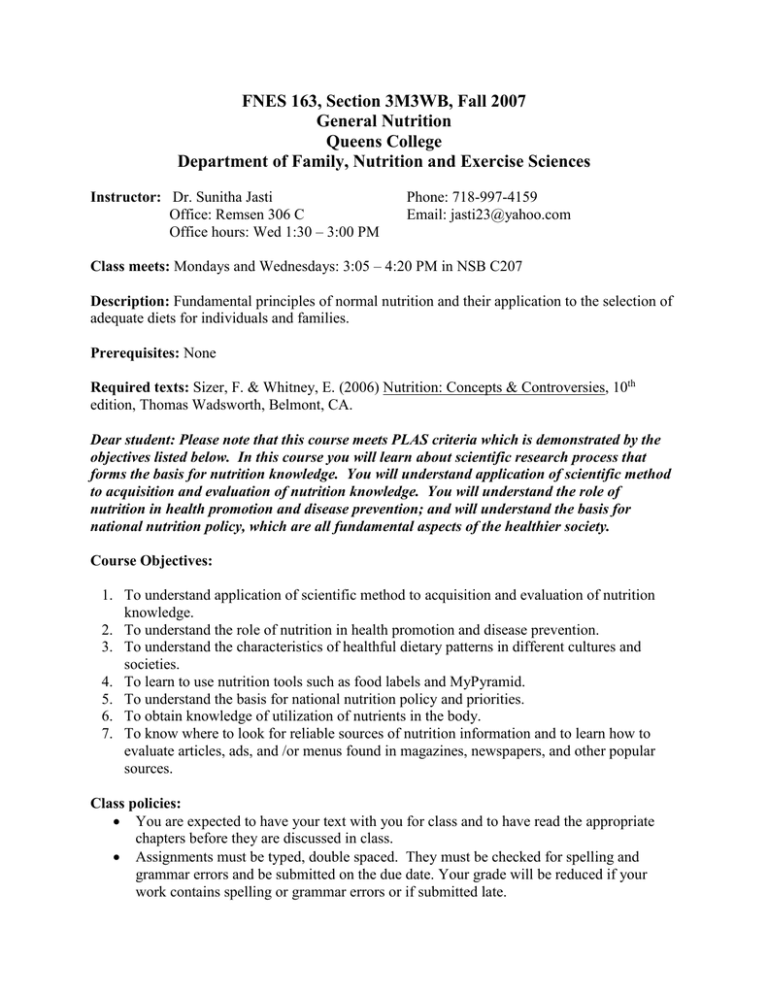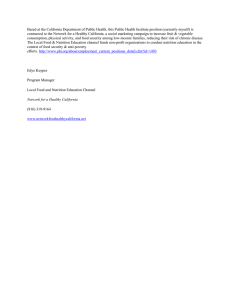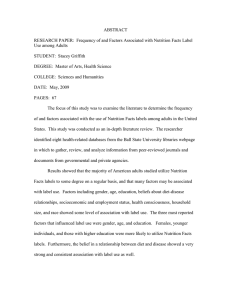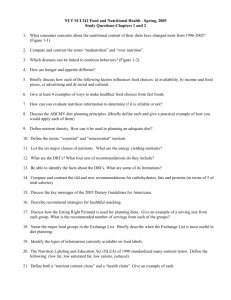FNES 163, Section 3M3WB, Fall 2007 General Nutrition Queens College
advertisement

FNES 163, Section 3M3WB, Fall 2007 General Nutrition Queens College Department of Family, Nutrition and Exercise Sciences Instructor: Dr. Sunitha Jasti Office: Remsen 306 C Office hours: Wed 1:30 – 3:00 PM Phone: 718-997-4159 Email: jasti23@yahoo.com Class meets: Mondays and Wednesdays: 3:05 – 4:20 PM in NSB C207 Description: Fundamental principles of normal nutrition and their application to the selection of adequate diets for individuals and families. Prerequisites: None Required texts: Sizer, F. & Whitney, E. (2006) Nutrition: Concepts & Controversies, 10th edition, Thomas Wadsworth, Belmont, CA. Dear student: Please note that this course meets PLAS criteria which is demonstrated by the objectives listed below. In this course you will learn about scientific research process that forms the basis for nutrition knowledge. You will understand application of scientific method to acquisition and evaluation of nutrition knowledge. You will understand the role of nutrition in health promotion and disease prevention; and will understand the basis for national nutrition policy, which are all fundamental aspects of the healthier society. Course Objectives: 1. To understand application of scientific method to acquisition and evaluation of nutrition knowledge. 2. To understand the role of nutrition in health promotion and disease prevention. 3. To understand the characteristics of healthful dietary patterns in different cultures and societies. 4. To learn to use nutrition tools such as food labels and MyPyramid. 5. To understand the basis for national nutrition policy and priorities. 6. To obtain knowledge of utilization of nutrients in the body. 7. To know where to look for reliable sources of nutrition information and to learn how to evaluate articles, ads, and /or menus found in magazines, newspapers, and other popular sources. Class policies: You are expected to have your text with you for class and to have read the appropriate chapters before they are discussed in class. Assignments must be typed, double spaced. They must be checked for spelling and grammar errors and be submitted on the due date. Your grade will be reduced if your work contains spelling or grammar errors or if submitted late. Exams are based on class notes, textbook chapters and other readings (if any), and assignments. Final exam will be cumulative. Please bring a #2 pencil, eraser and a calculator for each exam. There will not be extra credit assignments or an option for incomplete grade. Plagiarism in any form including cheating in exams will result in a failing grade and/or will be reported to administrative authorities. Turn off your cell phones for the class duration. Students with disabilities needing academic accommodation should contact the Special Services Office: 171 Kiely Hall, 718-997-5879. Tentative Class Schedule: Changes may be announced in class 8/27 8/29 9/3 9/5 9/10 9/12 9/17 9/19 9/24 9/26 10/1 10/3 10/8 10/10 10/15 10/17 10/22 Introduction Food choices and human health (Ch. 1) Labor day No class Nutrition Tools (Ch. 2) My Pyramid, Dietary guidelines Rosh Hashana No class DRIs, Food labels The Digestive System (Ch. 3) Carbohydrates (Ch. 4) Exam 1 ch 1 & 2 Lipids (Ch. 5) Columbus day No class Proteins (Ch. 6) 10/24 10/29 10/31 11/5 11/7 11/12 11/14 11/19 11/21 11/26 11/28 12/3 12/5 12/10 12/12 12/17 Exam 2 ch 3, 4 & 5 Vitamins (Ch. 7) Exam 3 ch 6 & 7 Water and minerals (Ch. 8) Friday schedule No class Trace minerals Maternal nutrition Exam 4 ch 8 Energy balance and body weight Review Snow date Final exam 1:15 – 3:15pm Your grade will be computed as follows: Exams 1, 2, 3 and 4 (15% each) Assignments Final exam 60% 15% 25% Current academic standards at Queens College will be strictly adhered to: A+ A A- 97 – 100 B+ 93 – 96 B 90 - 92 B- 87 – 89 C+ 83 – 86 C 80 – 82 C- 77 – 79 D+ 73 – 76 D 70 - 72 F 67 – 69 60 – 66 59 – Assignments 1. Assessment of your own diet using MyPyramid (10%) – Due September 24, 2007. Record all foods and beverages you consumed over a 24-hour period, including the amounts. Now go to mypyramid.gov website, and assess your 24-hr diet by choosing your age and gender category and comparing your intakes with the recommendations. Write up your assessment in 1-2 double-spaced pages and this should include answers to the following questions. a. Did you consume all food groups in adequate amounts? If not, which groups were you deficient in? b. Were there any food groups that you consumed too much of? If so, what were they? c. From each of the food groups, assess your food selections in terms of nutrient density. Specify foods that were nutrient dense and for items with low nutrient density, suggest alternate choices with higher nutrient density. Comment on reasons for your choices for one item in each food group (either of high nutrient density or of low nutrient density). d. Based on the five characteristics of a nutritious diet, do you consider your diet healthy? Comment on how you rate yourself on each characteristic. Which of the characteristics are difficult to judge? And why? e. What changes would you recommend to improve your diet? 2. Evaluate saturated and trans fats on food labels (5%) – Due October 15, 2007. Details to be given later.




